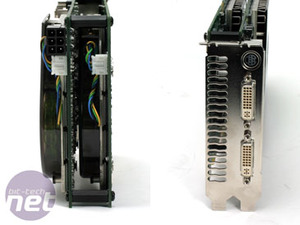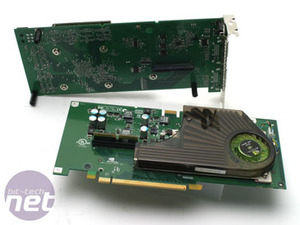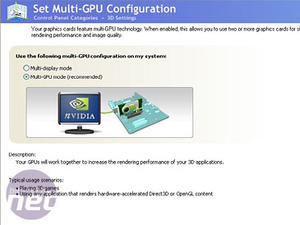
There is only a single power connector - this is another change for the good, as GeForce 7900 GX2 required a pair of six pin PCI-Express power connectors in order to function correctly. NVIDIA claims that a single GeForce 7950 GX2 consumes around 142W of power, compared to the 120W of a single GeForce 7900 GTX and the 80W consumed by GeForce 7900 GT. The company also stated that the card will run of a 400W power supply unit, providing it has at least 27A of current available on one of its 12V power lines.

 The card has a pair of dual-link DVI connectors, but there is a snag. The card has two operating modes - dual GPU or dual display. This option is controlled from within NVIDIA's driver control panel, and is similar to turning SLI on. Essentially, that is what GeForce 7950 GX2 is - it's a pair of GeForce 7900 GTs with 512MB frame buffers on a single card, or in other words, it's SLI on a single card.
The card has a pair of dual-link DVI connectors, but there is a snag. The card has two operating modes - dual GPU or dual display. This option is controlled from within NVIDIA's driver control panel, and is similar to turning SLI on. Essentially, that is what GeForce 7950 GX2 is - it's a pair of GeForce 7900 GTs with 512MB frame buffers on a single card, or in other words, it's SLI on a single card.
For those running dual displays, this comes as a bit of an annoyance, as you will have to enable and then disable dual GPU every time you want to game at this cards' maximum potential. If there was the possibility of an on the fly method, whereby the driver detects whether the card is running in 3D or not, we're sure that it would go down incredibly well with avid users of dual displays. This isn't an incredible issue, but it's one of those niggles that multi-GPU owners currently have to put up with.
 Along with the dual dual-link DVI connectors, there is a HDTV Out connection. One thing that is different about these connections is that they're all HDCP-compliant. This is NVIDIA's first retail HDCP-compliant product, meaning that every GeForce 7950 GX2 video card includes the crypto-ROM chip that stores the keys used for HDCP encoding of HDCP-protected digital video streams. Hopefully more video cards will start to include HDCP-compliancy as a feature, as HD video streams are soon to become a big part of the digital home.
Along with the dual dual-link DVI connectors, there is a HDTV Out connection. One thing that is different about these connections is that they're all HDCP-compliant. This is NVIDIA's first retail HDCP-compliant product, meaning that every GeForce 7950 GX2 video card includes the crypto-ROM chip that stores the keys used for HDCP encoding of HDCP-protected digital video streams. Hopefully more video cards will start to include HDCP-compliancy as a feature, as HD video streams are soon to become a big part of the digital home.
When SLI originally launched, there were no multi-GPU platforms available on the market, meaning that minor bugs and problems were accepted because it was early technology. CrossFire got a bit of flak when it was first launched, because it was also full of bugs and problems; at that time, the goal posts had moved, as CrossFire already had a competitor.
In that respect, Quad SLI faced competition from both SLI and CrossFire because - at worst - we expected it to be no slower than NVIDIA's current SLI implementation; at best, we expected great things. We love new technology as much as any other hardware enthusiast, but unfortunately for NVIDIA, it set the standards with SLI technology and ATI followed closely behind with CrossFire.
When we were given the chance to look at Quad SLI using a pair of GeForce 7900 GX2s, the product was already shipping to paying customers - these customers would have to put up with the problems. As a result of NVIDIA setting the standards for multi-GPU, we had to evaluate it as a shipping product. We will revisit Quad SLI with GeForce 7950 GX2 when we get a driver revision that allows a pair of these babies to work in tandem.
GeForce 7950 GX2 functions as any normal single card solution would, in that it will work in virtually any motherboard with a PCI-Express x16 interconnect, regardless of the chipset. Compatible motherboards will need a BIOS update to ensure that it is able to see the second GPU that is hidden behind the internal PCI-Express switch. For an up-to-date list of motherboards that support GeForce 7950 GX2, you can check over on NVIDIA's homepage.


For those running dual displays, this comes as a bit of an annoyance, as you will have to enable and then disable dual GPU every time you want to game at this cards' maximum potential. If there was the possibility of an on the fly method, whereby the driver detects whether the card is running in 3D or not, we're sure that it would go down incredibly well with avid users of dual displays. This isn't an incredible issue, but it's one of those niggles that multi-GPU owners currently have to put up with.

Quad SLI:
At the moment, NVIDIA is only officially supporting Quad SLI (a pair of GeForce 7950 GX2s) via authorised system integrators - DIY hardware enthusiasts will have to hold tight for official support. This is because the Quad SLI drivers are not 100% ready and NVIDIA said that it wanted to make sure that things were good to go before unleashing it on the DIY community.When SLI originally launched, there were no multi-GPU platforms available on the market, meaning that minor bugs and problems were accepted because it was early technology. CrossFire got a bit of flak when it was first launched, because it was also full of bugs and problems; at that time, the goal posts had moved, as CrossFire already had a competitor.
In that respect, Quad SLI faced competition from both SLI and CrossFire because - at worst - we expected it to be no slower than NVIDIA's current SLI implementation; at best, we expected great things. We love new technology as much as any other hardware enthusiast, but unfortunately for NVIDIA, it set the standards with SLI technology and ATI followed closely behind with CrossFire.
When we were given the chance to look at Quad SLI using a pair of GeForce 7900 GX2s, the product was already shipping to paying customers - these customers would have to put up with the problems. As a result of NVIDIA setting the standards for multi-GPU, we had to evaluate it as a shipping product. We will revisit Quad SLI with GeForce 7950 GX2 when we get a driver revision that allows a pair of these babies to work in tandem.
Motherboard compatibility:
First off, it should be reasonably obvious that a pair of GeForce 7950 GX2s in Quad SLI will only work on NVIDIA SLI-certified motherboards. However, NVIDIA has tested GeForce 7950 GX2 on a number of motherboard solutions, including boards with only a single PCI-Express x16 interconnect.GeForce 7950 GX2 functions as any normal single card solution would, in that it will work in virtually any motherboard with a PCI-Express x16 interconnect, regardless of the chipset. Compatible motherboards will need a BIOS update to ensure that it is able to see the second GPU that is hidden behind the internal PCI-Express switch. For an up-to-date list of motherboards that support GeForce 7950 GX2, you can check over on NVIDIA's homepage.

MSI MPG Velox 100R Chassis Review
October 14 2021 | 15:04








Want to comment? Please log in.